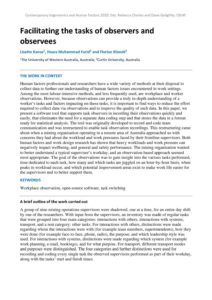| Document | Author Lisette Kanse, Hawa Muhammad Farid and Florian Klonek |
| Abstract Human factors professionals and researchers have a wide variety of methods at their disposal to collect data to further our understanding of human factors issues encountered in work settings. Among the most labour-intensive methods, and less frequently used, are workplace and worker observations. However, because observations can provide a truly in-depth understanding of a worker’s tasks and factors impacting on these tasks, it is important to find ways to reduce the effort required to collect data via observations and to improve the quality of such data. In this paper, we present a software tool that supports task observers in recording their observations quickly and easily, that eliminates the need for a separate data coding step and that stores the data in a format ready for statistical analysis. The tool was originally developed to record and code team communication and was restructured to enable task observation recordings. This restructuring came about when a mining organisation operating in a remote area of Australia approached us with concerns they had about the workload and work pressures faced by their frontline supervisors. Both human factors and work design research has shown that heavy workloads and work pressure can negatively impact wellbeing, and general and safety performance. The mining organisation wanted to better understand a typical supervisor’s workday, and an observation-based approach seemed most appropriate. The goal of the observations was to gain insight into the various tasks performed, time dedicated to each task, how many and which tasks are juggled on an hour-by-hour basis, when peaks in workload occur, and which potential improvement areas exist to make work life easier for the supervisors and to better support them. |

